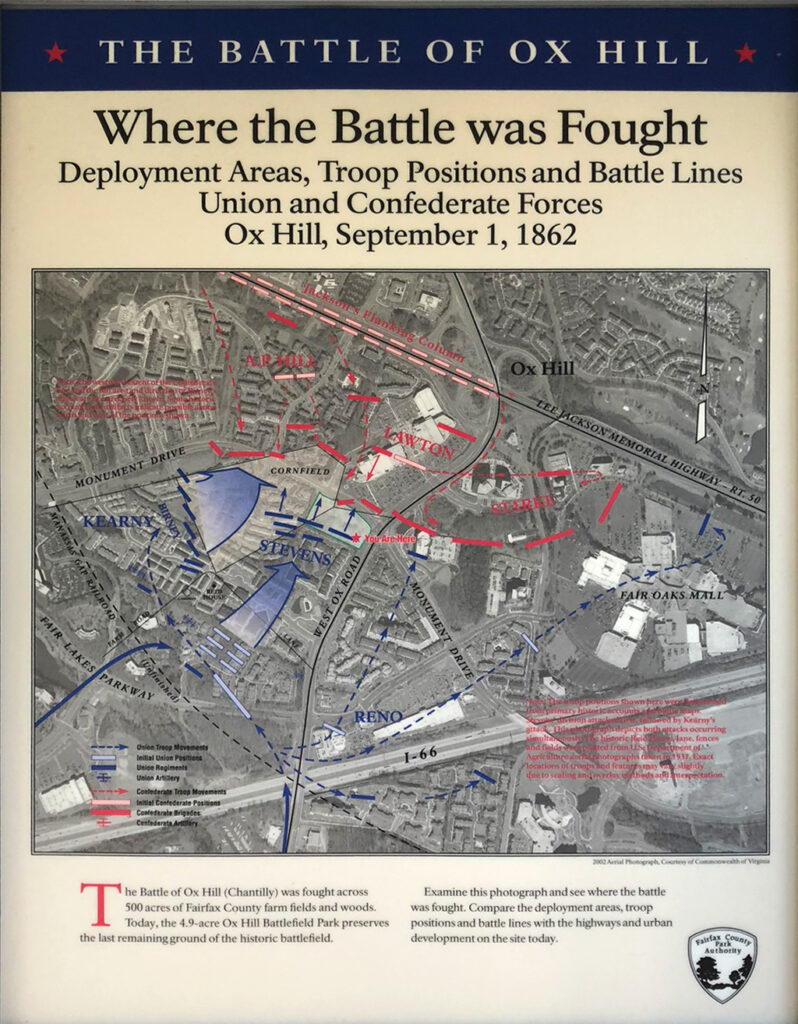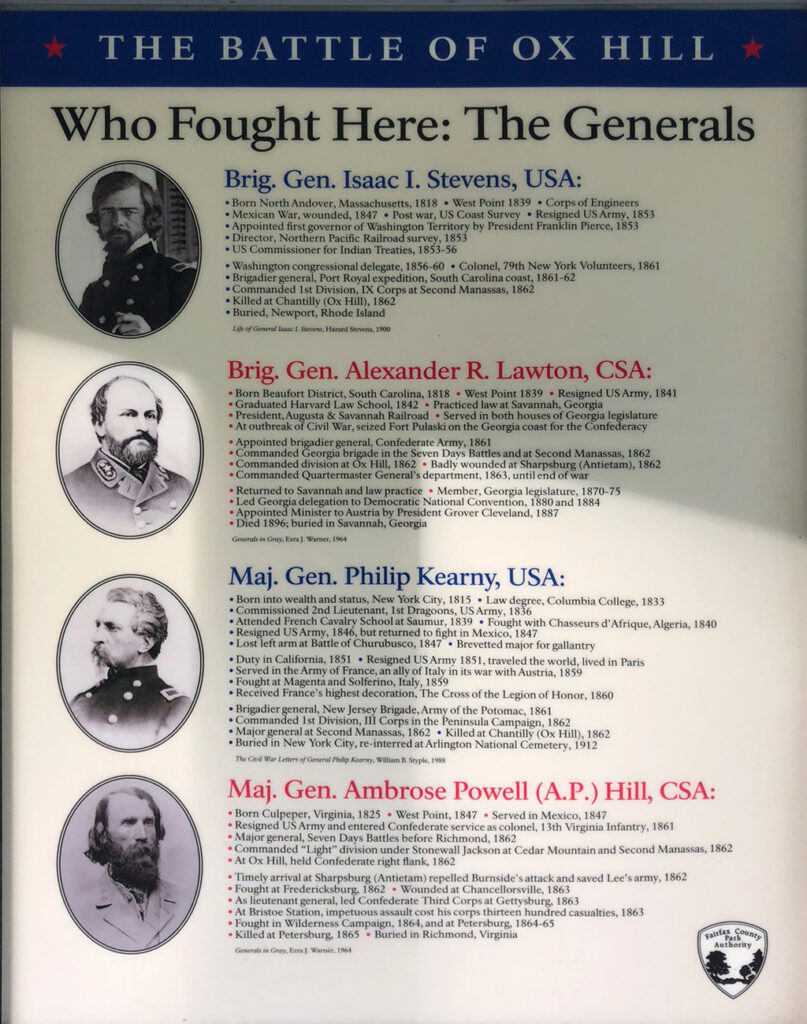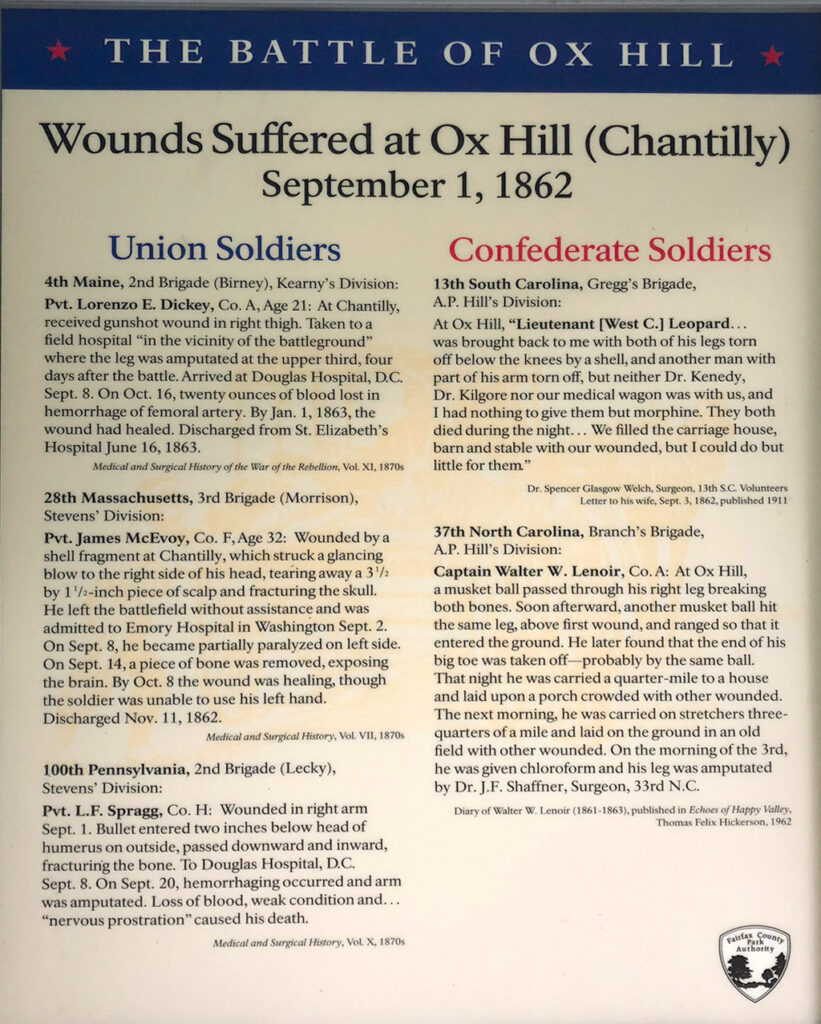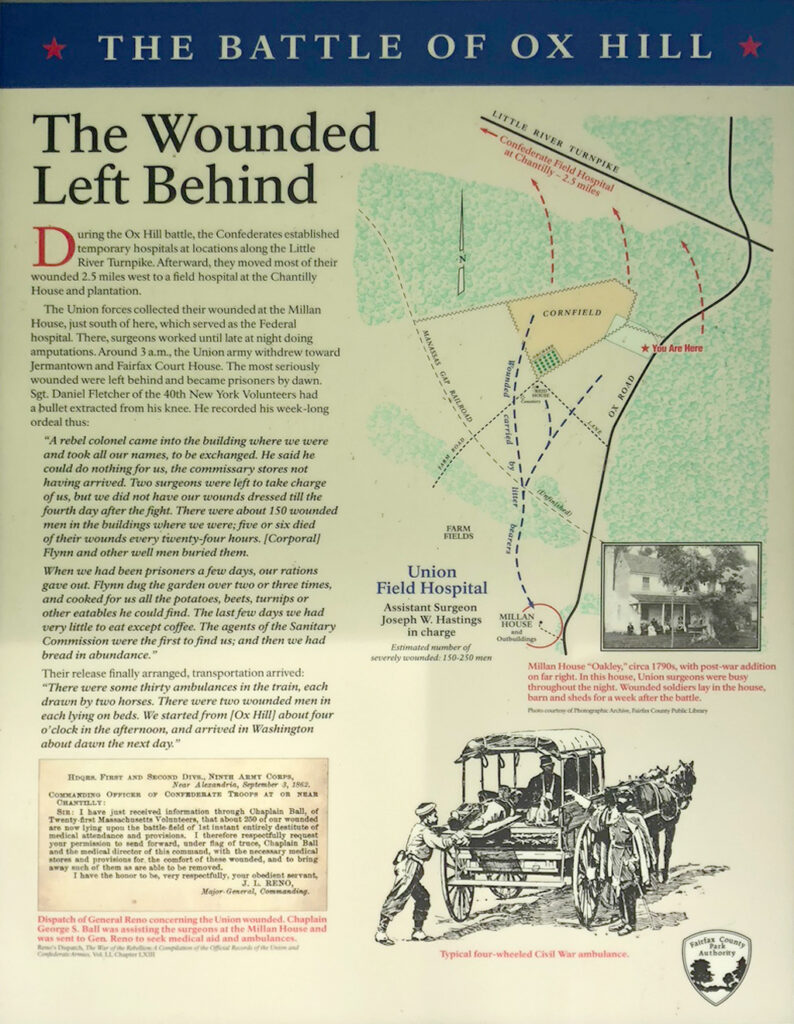Chantilly Main Page * About the Battle * Ox Hill Battlefield Park * The Armies
Three information kiosks are located next to a small (7 spaces) parking area at the entrance to Ox Hill Battlefield Park. All were erected in 2008 by the Fairfax County Park Authority
Ox Hill Battlefield Park & Interpretive Trail
This small park is the last remnant of Fairfax County’s only major Civil War battlefield. The Battle of Ox Hill, also known as the “Battle of Chantilly,” lasted but a few hours on the afternoon of September 1, 1862. Here, some 6,000 Union troops encountered and attacked about 17,000 Confederates of General Stonewall Jackson. It was a “beastly, comfortless conflict” fought during a ferocious thunderstorm.
As darkness fell and the fighting ceased, hundreds of soldiers lay dead and more than a thousand were wounded or missing. Two of the most promising generals in the Union army, Isaac Stevens and Philip Kearny, were among the slain. The bloody stalemate frustrated the Confederate attempt to intercept and destroy General John Pope’s Union army as it retreated toward Washington following the Battle of Second Manassas (Bull Run).
Interpretive Trail
Follow the loop trail through this surviving portion of the battlefield. Visit the wayside markers labeled 1-9 and learn how the battle progressed and its aftermath. Read soldiers’ descriptions of the action, discover how generals Stevens and Kearny fell, view the monuments and learn the fate of the wounded.
Information Kiosks
Sequel to Second Manassas
The Battle of Ox Hill, September 1, 1862
The Confederate victory at Second Manassas (August 28-30, 1862) forced Union General John Pope’s Army of Virginia to retreat to the heights of Centreville. To dislodge Pope from his strong Centreville positions, Confederate General Robert E. Lee, commanding the Army of Northern Virginia, ordered General Thomas J. “Stonewall” Jackson’s 17,000 troops on a flank march to cut off Pope’s army from Washington.
Heavy rains hindered Jackson’s march on August 31, but by the afternoon of September 1 his column was advancing toward Fairfax Court House on the Little River Turnpike. Alerted to this threat, Pope assembled a force at Jermantown to block Jackson’s path and directed the IX Corps, some 4,000 troops, toward Jackson’s right flank. Sharp fighting erupted as General Isaac Stevens’ division made contact with Jackson’s column at Ox Hill. Storm clouds darkened the sky as Stevens launched an attack on the Confederates in the woods. The general was killed while gallantly leading this assault. As Stevens fell, a violent thunderstorm struck with gale force winds.
With rain falling in torrents, the lead brigade of General Philip Kearny’s division, III Corps, arrived with 2,000 more troops and resumed Stevens’ attack. Scouting the ground in his front amid the downpour, Kearny accidentally rode into Confederate lines and was killed while trying to escape.
Despite wet ammunition, the bloodshed continued until darkness brought an indecisive end to the struggle. There was no tactical resolution—only exhaustion, the wounded and the dead. During the night, Union forces withdrew and eventually reached the safety of Washington’s defenses. Lee’s Army of Northern Virginia marched toward Leesburg and, on September 4, began fording the Potomac River, initiating the Maryland Campaign.
Where the Battle was Fought
Deployment Areas, Troop Positions and Battle Lines
Union and Confederate Forces
The Battle of Ox Hill (Chantilly) was fought across 500 acres of Fairfax County farm fields and woods. Today, the 4.9-acre Ox Hill Battlefield Park preserves the last remaining ground of the historic battlefield. Examine this photograph and see where the battle was fought. Compare the deployment areas, troop positions and battle lines with the highways and urban development on the site today.
Who Fought Here: The Generals
Brig. Gen. Isaac I. Stevens, USA:
• Born North Andover, Massachusetts, 1818 • West Point 1839 • Corps of Engineers
• Mexican War, wounded, 1847 • Post war, US Coast Survey • Resigned US Army, 1853
• Appointed first governor of Washington Territory by President Franklin Pierce, 1853
• Director, Northern Pacific Railroad survey, 1853
• US Commissioner for Indian Treaties, 1853-56
• Washington congressional delegate, 1856-60 • Colonel, 79th New York Volunteers, 1861
•Brigadier general, Port Royal expedition, South Carolina coast, 1861-62
• Commanded 1st Division, IX Corps at Second Manassas, 1862
• Killed at Chantilly (Ox Hill), 1862
• Buried, Newport, Rhode Island
Life of General Isaac I. Stevens, Hazard Stevens, 1900
Brig. Gen. Alexander R. Lawton, CSA:
• Born Beaufort District, South Carolina, 1818 • West Point 1839 • Resigned US Army, 1841
• Graduated Harvard Law School, 1842 • Practiced law at Savannah, Georgia
• President, Augusta & Savannah Railroad • Served in both houses of Georgia legislature
• At outbreak of Civil War, seized Fort Pulaski on the Georgia coast for the Confederacy
• Appointed brigadier general, Confederate Army, 1861
• Commanded Georgia brigade in the Seven Days Battles and at Second Manassas, 1862
• Commanded division at Ox Hill, 1862 • Badly wounded at Sharpsburg (Antietam), 1862
• Commanded Quartermaster General’s department, 1863, until end of war
• Returned to Savannah and law practice • Member, Georgia legislature, 1870-75
• Led Georgia delegation to Democratic National Convention, 1880 and 1884
• Appointed Minister to Austria by President Grover Cleveland, 1887
• Died 1896, buried in Savannah, Georgia
Generals in Gray, Ezra J. Warner, 1964
Maj. Gen. Philip Kearny, USA:
• Born into wealth and status, New York City, 1815 • Law degree, Columbia College, 1833
• Commissioned 2nd Lieutenant, 1st Dragoons, US Army, 1836
• Attended French Cavalry School at Saumur, 1839 • Fought with Chasseur’s d’Afrique, Algeria, 1840
• Resigned US Army, 1846, but returned to fight in Mexico, 1847
• Lost left arm at Battle of Churubusco, 1847 • Brevetted major for gallantry
• Duty in California, 1851
• Resigned US Army 1851, traveled the world, lived in Paris
• Served in the Army of France, an ally of Italy in its war with Austria, 1859
• Fought at Magenta and Solferino, Italy, 1859
• Received France’s highest decoration, The Cross of the Legion of Honor, 1860
• Brigadier general, New Jersey Brigade, Army of the Potomac, 1861
• Commanded 1st Division, III Corps in the Peninsula Campaign, 1862
• Major general at Second Manassas, 1862 • Killed at Chantilly (Ox Hill), 1862
• Buried in New York City, re-interred at Arlington National Cemetery, 1912
The Civil War Letters of General Philip Kearny, William B. Styple, 1988
Maj. Gen. Ambrose Powell (A.P.) Hill, CSA:
• Born Culpeper, Virginia, 1825 • West Point, 1847 • Served in Mexico, 1847
• Resigned US Army and entered Confederate service as colonel, 13th Virginia Infantry, 1861
• Major general, Seven Days Battles before Richmond, 1862
• Commanded “Light” division under Stonewall Jackson at Cedar Mountain and Second Manassas, 1862
• At Ox Hill, held Confederate right flank, 1862
• Timely arrival at Sharpsburg (Antietam) repelled Burnside’s attack and saved Lee’s army, 1862
• Fought at Fredericksburg, 1862 • Wounded at Chancellorsville, 1863
• As lieutenant general, led Confederate Third Corps at Gettysburg, 1863
• At Bristoe Station, impetuous assault cost his corps thirteen hundred casualties, 1863
• Fought in Wilderness Campaign, 1864, and at Petersburg, 1864-65
• Killed at Petersburg, 1865 • Buried in Richmond, Virginia
Generals in Gray, Ezra J. Warner, 1964
Wounds Suffered at Ox Hill (Chantilly)
September 1, 1862
Union Soldiers
4th Maine, 2nd Brigade (Birney), Kearny’s Division:
Pvt. Lorenzo E. Dickey, Co. A, Age 21: At Chantilly, received gunshot would in right thigh. Taken to a field hospital “in the vicinity of the battleground” where the leg was amputated at the upper third, four days after the battle. Arrived at Douglas Hospital, D.C. Sept. 8. On Oct. 16, twenty ounces of blood lost in hemorrhage of femoral artery. By Jan. 1, 1863, the wound had healed. Discharged from St. Elizabeth’s Hospital June 16, 1863. Medical and Surgical History of the War of the Rebellion, Vol. XI, 1870s
28th Massachusetts, 3rd Brigade (Morrison), Stevens’ Division:
Pvt. James McEnvoy, Co. F, Age 32: Wounded by a shell fragment at Chantilly, which struck a glancing blow to the right side of his head, tearing away a 3 ½ by 1 ½ -inch piece of scalp and fracturing the skull. He left the battlefield without assistance and was admitted to Emory Hospital in Washington Sept. 2. On Sept. 8, he became partially paralyzed on the left side. On Sept. 14, a piece of bone was removed, exposing the brain. By Oct. 8 the wound was healing, though the soldier was unable to use his left hand. Discharged Nov. 11, 1862. Medical and Surgical History Vol. VII, 1870s
100th Pennsylvania, 2nd Brigade (Lecky), Stevens’ Division:
Pvt. L.F. Spragg, Co. H: Wounded in right arm Sept. 1. Bullet entered two inches below head of humerous on outside, passed downward and inward, fracturing the bone. To Douglas Hospital, D.C. Sept. 8. On Sept. 20, hemorrhaging occurred and arm was amputated. Loss of blood, weak condition and … “nervous prostration” caused his death. Medical and Surgical History, Vol. X, 1870s
Confederate Soldiers
13th South Carolina, Gregg’s Brigade, A.P. Hill’s Division:
At Ox Hill, Lieutenant [West C.] Leopard…was brought back to me with both of his legs torn off below the knees by a shell, and another man with part of his arm torn off, but neither Dr. Kenedy, Dr. Kilgore nor our medical wagon was with us, and I had nothing to give them but morphine. They both died during the night… We filled the carriage house, barn and stable with our wounded, but I could not do but little for them.” Dr. Spencer Glasgow Welch, Surgeon, 13th S.C. Volunteers Letter to his wife, Sept. 3, 1862, published 1911
37th North Carolina, Branch’s Brigade, A.P. Hill’s Division:
Captain Walter W. Lenior, Co. A: At Ox Hill, a musket ball passed through his right leg breaking both bones. Soon afterward, another musket ball hit the same leg, above the first wound, and ranged so that it entered the ground. He later found that the end of his big toe was taken off—probably by the same ball. That night he was carried a quarter-mile to a house and laid upon a porch crowded with other wounded. The next morning, he was carried by stretchers three-quarters of a mile and laid on the ground in an old field with other wounded. On the morning of the 3rd he was given chloroform and his leg was amputated by Dr. J.F. Shaffner, Surgeon, 33rd N.C. Diary of Walter W. Lenoir (1861-1863), published in Echoes of Happy Valley, Thomas Felix Henderson, 1962
The Wounded Left Behind
During the Ox Hill battle, the Confederates established temporary hospitals at locations along the Little River Turnpike. Afterward, they moved most of their wounded 2.5 miles west to a field hospital at the Chantilly House and plantation.
The Union forces collected their wounded at the Millan House, just south of here, which served as the Federal hospital. There, surgeons worked until late at night doing amputations. Around 3 a.m., the Union army withdrew toward Jermantown and Fairfax Court House. The most seriously wounded were left behind and became prisoners by dawn. Sgt. Daniel Fletcher of the 40th New York Volunteers had a bullet extracted from his knee. He recorded his week-long ordeal thus:
“A rebel colonel came into the building where we were and took all our names, to be exchanged. He said he could do nothing for us, the commissary stores not having arrived. Two surgeons were left to take charge of us, but we did not have our wounds dressed till the fourth day after the fight. There were about 150 wounded men in the buildings where we were; five or six died of their wounds every twenty-four hours. [Corporal] Flynn and other well men buried them.
When we had been prisoners a few days, our rations gave out. Flynn dug the garden over two or three times, and cooked for us all the potatoes, beets, turnips or other eatables he could find. The last few days we had very little to eat except coffee. The agents of the Sanitary Commission were the first to find us; and then we had bread in abundance.”
Their release finally arranged, transportation arrived: There were some thirty ambulances in the train, each drawn by two horses. There were two wounded men in each lying on beds. We started from [Ox Hill] about four o’clock in the afternoon, and arrived in Washington about dawn the next day.”
Location of the kiosks at Ox Hill Battlefield Park
The Ox Hill Battlefield Information Kiosk is located on the southeast side of the park, next to the small parking lot. (38°51’51.9″N 77°22’11.3″W) Access is from West Ox Road (County Road 608), 250 feet South of the intersection with Monument Drive and .4 mile south of the US 50 interchange.






